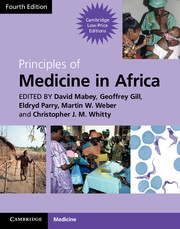Book contents
- Frontmatter
- Contents
- Contributors
- Foreword
- Section 1 Health and disease
- Section 2 Mother and child health
- Section 3 Infection: general principles
- Section 4 Major common infections
- Section 5 Bacterial infections
- Section 6 Viral Infections
- Section 7 Protozoal infections
- Section 8 Helminth infections
- 46 Intestinal helminths
- 47 Schistosomiasis
- 48 Lymphatic filariasis and loa loa
- 49 Onchocerciasis
- 50 Cysticercosis
- 51 Hydatid disease
- 52 Paragonimiasis
- 53 Trichinellosis
- 54 Guinea worm
- Section 9 Fungal infections
- Section 10 Non-communicable diseases
- Section 11 Diseases of body systems
- Section 12 Cancer and Palliative Care
- Section 13 Venoms and Poisons
- Index
- References
52 - Paragonimiasis
from Section 8 - Helminth infections
Published online by Cambridge University Press: 05 March 2013
- Frontmatter
- Contents
- Contributors
- Foreword
- Section 1 Health and disease
- Section 2 Mother and child health
- Section 3 Infection: general principles
- Section 4 Major common infections
- Section 5 Bacterial infections
- Section 6 Viral Infections
- Section 7 Protozoal infections
- Section 8 Helminth infections
- 46 Intestinal helminths
- 47 Schistosomiasis
- 48 Lymphatic filariasis and loa loa
- 49 Onchocerciasis
- 50 Cysticercosis
- 51 Hydatid disease
- 52 Paragonimiasis
- 53 Trichinellosis
- 54 Guinea worm
- Section 9 Fungal infections
- Section 10 Non-communicable diseases
- Section 11 Diseases of body systems
- Section 12 Cancer and Palliative Care
- Section 13 Venoms and Poisons
- Index
- References
Summary
The problem in Africa
Paragonimiasis is a food-borne disease caused by lung flukes of the genus Paragonimus. Humans acquire the infection by eating raw or under-cooked crustaceans. Paragonimiasis most frequently affects the lungs, yet extrapulmonary infection may affect any other organ system. Pulmonary paragonimiasis is characterized by a chronic productive cough, chest pains and haemoptysis and may easily be confused with pulmonary tuberculosis.
The main focus of paragonimiasis on the African continent is in West and Central Africa, with the largest number of cases reported from Nigeria and Cameroon. Paragonimiasis has been identified in Liberia, The Gambia, Gabon, Ivory Coast, Benin, Equatorial Guinea, Congo and the DRC. Single cases were also reported from Libya and South Africa.
The parasite and its life cycle
Paragonimus spp. are the only known mammalian lung flukes capable of infecting humans. The flukes lodge in the lungs of mammals such as wild and domestic cats, dogs, monkeys and humans. The hermaphrodite adults live as pairs in cavities in the lungs. They produce eggs which are either expectorated or swallowed and excreted via the faeces. Once Paragonimus ova reach water, further development takes place (Fig. 52.1). After about 3 weeks, a miracidium hatches. Miracidia are ingested by the first intermediate host which is a freshwater snail. After further development inside the snail, cercariae are produced. Cercariae are ingested by the second intermediate host, a crustacean (crab, shrimp or crayfish).
- Type
- Chapter
- Information
- Principles of Medicine in Africa , pp. 473 - 475Publisher: Cambridge University PressPrint publication year: 2013



